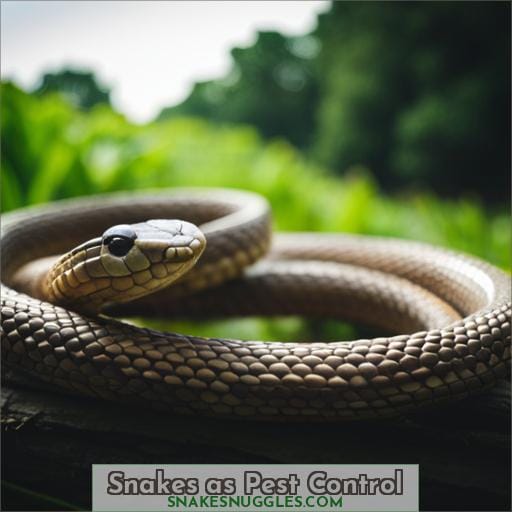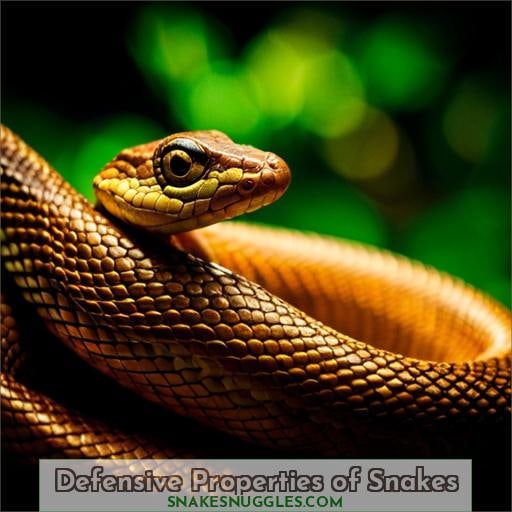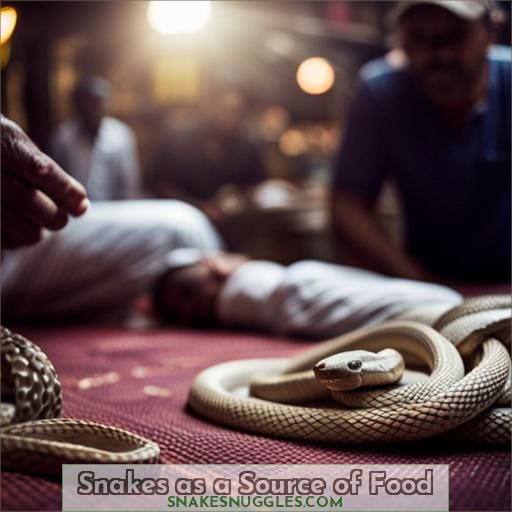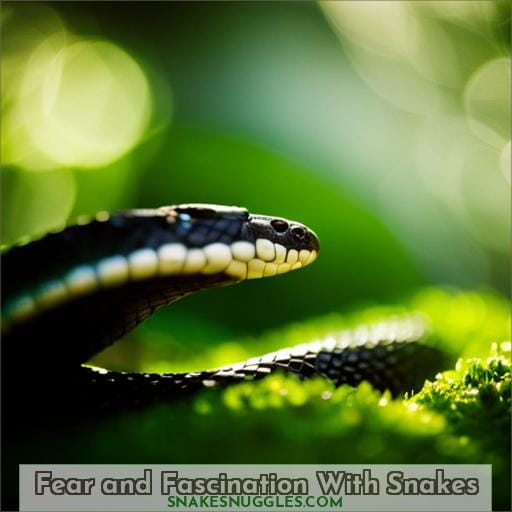This site is supported by our readers. We may earn a commission, at no cost to you, if you purchase through links.
 As you look around your garden, a scaly creature may catch your eye. Snakes, long feared for their venomous bite and mysterious behavior, are actually incredibly useful to humans.
As you look around your garden, a scaly creature may catch your eye. Snakes, long feared for their venomous bite and mysterious behavior, are actually incredibly useful to humans.
From pest control to medical research and even fashion industries – there is no shortage of how snakes help us! In this article, we will examine the various ways in which these reptiles benefit our lives.
We will also discuss why we have such an emotional reaction towards them with fear or fascination. Additionally, we will discuss the significance they serve in conservation efforts all over the world. This is not least of all because of their role in providing valuable insight into drug development through snake venom study.
Let’s dive into understanding how snakes can be so beneficial for humans!
Table Of Contents
Key Takeaways
- Snakes control pest populations, maintaining ecosystem balance.
- Snake venom is used in the medical field for coagulants and antivenom.
- Snake movement patterns inspire robotics and medical tool designs.
- Snakes have cultural significance across various cultures.
Snakes as Pest Control
You may not realize it, but snakes are incredibly beneficial to humans in numerous ways. From rodent regulation and insect control to providing medical research applications and cultural symbolism, these creatures have a rich purpose that extends far beyond the fear they evoke.
Rodent Regulation
You can rely on snakes to keep rodent populations in check, allowing for a more balanced and protected ecosystem. Venomous snake species like Eastern Indigo Snakes and King Snakes help control poisonous predators that may harm humans.
Plus, non-venomous breeds have adapted to eat toxic amphibians like toads for pest control.
Pet ownership of these reptiles is also beneficial as they consume rodents, which would otherwise be a food source for other animals or cause structural damage from their behaviors.
So not only do snakes serve as effective predators, but they provide an array of benefits when utilized responsibly by humans – making them invaluable members of our planet’s ecosystems, helping maintain balance with their vital role in pest regulation.
Insect Control
Snakes regulate insect populations, which helps protect crops and maintain balanced ecosystems. Insect-eating predatory snakes like the Eastern Indigo or Kingsnake have venom properties that aid in killing their prey.
Snake movement patterns are also studied for robotics development and medical applications such as hemostasis tools.
Conservation efforts have been put into place to ensure these animals can live naturally in their own environment without human interference while still benefiting us through animal research involving snake venom antibodies or other medicinal purposes.
Snakes play an integral role within our natural ecosystems, providing a valuable balance between humans and nature that must be protected with responsible practices of utilization.
Snakes in Scientific Research
Snakes have been a source of scientific research and technological advancements for centuries. Medical researchers study snake venom components to create antivenom, hemostasis tools, and drugs, while the movement patterns of snakes inspire robotics that is used in search-and-rescue operations.
Snakeskin is also studied for its permeability properties, which can be applied to drug absorption studies. These reptiles continue to surprise us with their many uses in modern science today.
Medical Research
Snakes’ remarkable venom has been studied for centuries, offering a wealth of medical possibilities that could help save lives. From harvesting and regulating potency to synthesizing components and understanding effects, snake venom has long played an integral role in scientific research.
Venom’s potency varies among species due to biochemical differences in composition.
Heat receptors allow snakes to detect warm-blooded prey, inspiring the development of synthetic venoms with similar properties for research purposes.
Poison tolerance testing helps researchers understand the impact certain toxins can have on humans and other animals at different doses or concentration levels.
Venom components are valuable tools used in hemostasis drugs, such as antivenom serums, which can be life-saving treatments against deadly bites from poisonous snakes like rattlesnakes or cobras.
Research into toxin regulation by cells is ongoing; this knowledge could help develop new therapies designed specifically to target cancerous tumors while leaving healthy tissue untouched.
Snake venom remains a crucial resource for advancing our medical understanding through careful study – leading the way toward potential cures!
Robotics and Technology
By studying the movement patterns of snakes, scientists have been able to create robots that can maneuver through tight spaces for search and rescue operations – up to 20 times faster than conventional methods.
Snakes’ infrared vision has helped them become nocturnal hunters. Their venom composition and defensive properties are also studied in robotics research. Different snake species boast different capabilities. Some specialize in swallowing prey whole or using constriction techniques, inspiring a range of designs for robots that replicate these behaviors.
With further understanding about how snakes react in various situations, advancements like autonomous navigation systems could be achieved based on the insights gained from snake behavior studies.
Defensive Properties of Snakes
You may be surprised to learn that snakes play a vital role in scientific research. Venom from certain snake species has been studied for its medical applications, such as the production of antivenom and hemostasis tools.
Additionally, snakeskin is utilized in medical research for modeling skin permeability studies and drug absorption examinations.
Venom Study and Antivenom Production
You can thank snakes for the development of antivenom and hemostasis tools, saving countless lives! Venom is studied to understand its components and create effective treatments.
Snake movement patterns have been utilized in robotics, aiding search and rescue operations. Snakes possess infrared vision for night hunting, which is helpful in urban areas where rat explosions occur due to their absence.
The Queensland Museum promotes conservation of species by educating people on how they help preserve natural balance, including snake bite prevention tips.
Snake venom has a variety of medical applications, like providing coagulants or platelet inhibition drugs, which prove useful when treating wounds or illnesses caused by infections–all thanks to these ancient yet important creatures!
Snakeskin in Medical Research
Discover how the unique texture and patterns of snakeskin have been employed in medical research to model skin permeability for drug absorption studies.
Snakeskin is waterproof, pliable, and has cultural significance as clothing. It can also be used for coagulants or platelet inhibition purposes due to its ability to serve as a control medium in experiments about infrared vision and prey selection.
Rat explosions caused by removing snakes from an environment demonstrate the importance of snake conservation and maintaining ecosystem balance.
In addition, their symbolic power across various cultures speaks volumes about nature’s intricate science – one that we must strive towards understanding with media literacy awareness at its core.
Snakes as a Source of Food
Throughout history, snakes have been both feared and revered for their unique properties. They are not only culturally significant but also a source of food in many cultures, while their skin has become a popular material in the fashion industry.
Cultural Consumption
Experience the symbolic significance of snakeskin fashion—from cowboy boots to belts and wallets—that has been used for centuries. Consumption of snakes as food is also practiced in various cultures, such as snake soup and other dishes found in China and Vietnam.
This consumption often carries cultural symbolism associated with fertility, healing, or protection. Snake leather has a unique texture pattern that is appreciated by many people looking for fashion accessories like belts or shoes crafted from it due to its waterproof nature.
Remnants from limb evolution can be seen on the scales of a snake’s skin, which make them appealing to some individuals who believe they have medicinal properties when worn against their body, teaching suggestions about liminality between humans and animals.
Snakeskin in Fashion Industry
Feel the unique texture and patterns of snakeskin as you explore its use in the fashion industry. Luxury items such as belts, bags, and shoes are crafted from it due to its pliability and waterproofness.
Snake leather has been sought after for centuries – not just for practical reasons but also cultural symbolism.
From Egyptian pharaohs wearing crowns with snake motifs to Native American fertility rituals, snakeskin is connected to many beliefs across different civilizations. In modern times, this wild catch material has become a trend among luxury brands looking for something special in their designs.
Whether it’s used as an accessory or garment item – let yourself be inspired by these fascinating creatures!
Fear and Fascination With Snakes
Snakes have always captivated the human imagination, appearing in ancient Egyptian culture on pharaoh crowns and associated with river gods in China. In more recent times, they are increasingly seen as a species worth protecting due to their vital role in ecosystems and cultural significance across many civilizations.
Cultural and Symbolic Significance
Explore how snakes have captivated the attention of civilizations across time with their mysterious symbolism, from Pharaoh’s crowns in ancient Egypt to Native American culture representing fertility and nature.
Marvel at these creatures’ unique ability to be both feared yet revered, each one as unique as a snowflake.
- Mythological symbolism is embedded in many cultures worldwide. Chinese zodiac signs, Greek caduceus symbols, and Hindu temples all feature snake imagery.
- Traditional healing practices use snake leather for spiritual protection or crafting items like belts or wallets due to its waterproof pliability.
- Exotic pet owners keep snakes for companionship while fashion houses utilize their skins for creating boots, bags, and shoes.
- Snake soup is consumed by some cultures along with other dishes made using this creature found throughout the world, adding another layer to our relationship with them!
Conservation and Protection
You can help protect snake species by following laws that limit or prohibit the capture and trade of wild snakes. Conservation efforts, such as protecting habitats and monitoring species, are essential to preserving these creatures in their natural environment.
Education programs raise awareness about respecting wildlife and understanding how important they are for maintaining balance in ecosystems. Snake diets must also be monitored to ensure populations remain healthy; certain animals may require special care when kept as pets due to unique dietary needs.
Snake Venom and Medical Applications
Snakes are much more than just creatures of fascination; their venom has been used for medical research and development for centuries. Venomous snakes produce a complex cocktail of toxins, which scientists have utilized to create antivenoms as well as drugs that help control blood clotting or inhibit platelets.
How Venom Works
Discover how the unique and powerful properties of snake venom have been harnessed by humans for medical research, leading to breakthroughs in drug absorption studies and antivenom creation.
Snake venom components can be used as coagulants, platelet inhibitors, or search robots inspired by their movement patterns, and even have therapeutic applications in venom-based treatments
.
Infrared vision found in some species is also beneficial for night hunting applications.
Symbolism associated with snakes dates back centuries. They appear on pharaoh’s crowns in Ancient Egypt or are represented as rubber boas for fertility rituals in Native American cultures.
Snakes continue to play an invaluable role that we are only just beginning to understand fully!
Drug Development From Snake Venom
Unlock the potential of snake venom and see how it can be used to develop medicines for various medical applications. By studying the biology of snakes, their unique hunting strategies, and properties of venom, scientists have been able to create a variety of treatments.
Venom components like coagulants are used in blood clotting, while others inhibit platelet activities or even paralyze prey.
With further research into utilizing snake venom safely and effectively, we can unlock more potential that could improve our lives today!
Frequently Asked Questions (FAQs)
What is the most common species of snake kept as a pet?
The most common pet snake is the corn snake. With its striking colors and patterns, it’s no wonder this reptile has become a symbol of freedom and safety to many. Its gentle nature makes it an ideal companion for those seeking understanding in their lives.
Are snakes beneficial to the environment?
Yes, snakes are beneficial to the environment. They serve as pest control by preying on harmful rodents and insects that damage crops, helping maintain balanced ecosystems. Snakes also consume venomous species, reducing the risk of harm to humans. Conservation efforts are crucial for preserving their important roles in nature.
What types of snakes are found in Australia?
In Australia, many snake species can be found, such as Eastern Indigo snakes, Kingsnakes, and Gopher snakes. These reptiles hunt rodents, birds, lizards, and insects while providing pest control in balanced ecosystems.
Furthermore, they are also used for medical research purposes due to their unique venom composition.
How do snakes hunt their prey?
Snakes hunt their prey using sight, smell, and tongue-flickering to detect movement. They ambush or stalk prey with stealthy movements before striking quickly with powerful muscles. Some species use venom to paralyze, while others constrict tightly around the victim until it stops breathing.
How can people safely coexist with snakes?
To coexist safely with snakes, take preventive measures such as clearing debris and overgrown vegetation. Avoid handling wild snakes and remain alert when outdoors. Respect their space, allowing them to feed on rodents that damage crops.
Conclusion
Though snakes have long been associated with fear and revulsion, they are integral to human life in more ways than we may realize. From providing pest control to aiding in medical research, snakes are an invaluable resource to humans.
Despite the common misconception that snakes are merely dangerous predators, they can also play a vital role in keeping ecosystems balanced and provide defensive properties.
Additionally, snakes are a source of nutrition and fashion. Their leather and skin are used to create products like shoes, wallets, and belts.
Finally, snake venom and its components have been used to develop drugs for medical purposes.
Ultimately, snakes are not to be feared but respected and appreciated for their important contributions to humanity.












